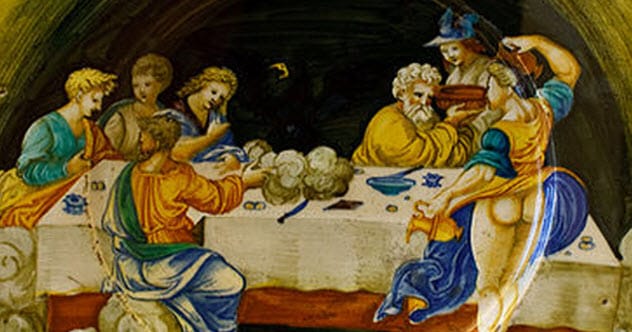Religion in the ancient world was incredibly diverse. Most societies were polytheistic, meaning they had many gods. People could easily offer sacrifices to Zeus one day and ask Artemis for help the next. But sometimes, people sought something more personal—a special connection with a divine figure. This led to the rise of cults, especially mystery cults, offering a unique path to heavenly attention.
Mithras
Across the Roman world, you can find intriguing underground chambers. Unlike grand Graeco-Roman temples, these subterranean sites were used by the cultists of Mithras. Over 200 Mithraeums have been found, many featuring sculptures of Mithras slaying a bull.
This image, known as a Tauroctony, was central to Mithras’s rites. Mithras is depicted as a young man holding a bull and plunging a sword into it. A snake and a dog are often shown lapping up the bull’s blood. Zodiac signs usually surround the image.
Much about the cult of Mithras remains mysterious. Despite the bloody imagery, there’s no evidence of actual bull slaughter at these sites. The members, typically all men and often in the military, would meet for communal meals. Brotherhood was a major aspect of their worship, with members calling themselves syndexioi—’those united by the handshake.’
The Kaali Crater
In ancient times, unexpected events were often attributed to the gods. Lightning and tornadoes were seen as signs of divine anger. So, imagine what people thought when, around 7,000 years ago, a meteorite exploded in Estonia with the force of the Hiroshima bomb.
The meteorite broke apart and created several craters. The Kaali crater, 110m across, is surrounded by a stone wall built by people who worshipped there. But the wall isn’t the only sign of worship.
Under the water are numerous bones, believed to be offerings. The crater was revered not just in pre-history; bones dating from the 1600s AD have also been found, showing continued reverence long after the original cult.
Cult of Sobek
Sobek was one of the oldest Egyptian gods. His name appears in texts as soon as writing developed in Egypt. Over time, Sobek’s influence grew, possibly because he had the head—and the fierce attitude—of a crocodile.
Egyptian civilization depended entirely on the Nile. Without its water, there would be no life in the desert. Without its annual floods, there would be no agriculture. As the god in charge of the flood, Sobek was considered one of the most important gods.
Followers of Sobek worshipped him by hunting and killing crocodiles. This might seem odd for a part-crocodile god, but for his worshippers, a crocodile was the ultimate sacrifice. Hunting crocodiles was dangerous, showing great honor to their god. Today, you can see mummified crocodiles, sometimes with their mummified young, in museums.
Cybele
What would you give up for your god? Today, many people offer only their Sunday mornings. But in the ancient world, gods could demand more extreme sacrifices. For the followers of Cybele, the ultimate sacrifice was castration in her honor.
Cybele originated as an ancient Turkish goddess associated with fertility. She later spread to Greece and Rome. She is often shown with an orgiastic procession, and her priests were known for erotic rites—until they castrated themselves.
March 24th was the ‘Day of Blood’ for Cybele’s followers. Some priests would castrate themselves and offer their blood on her altars. The Romans didn’t like castration, so they developed a substitution: sacrificing a bull instead.
Sabazios
Gods often resemble the humans who worship them. Sabazios, a Thracian god of horsemen, was often depicted as one. But the most distinctive image was a hand.
These metal hands have been found across Europe, following the Roman adoption of the god. The hands show three fingers extended in a blessing gesture, with a snake entwined around them. A pine-cone balances on the thumb, and a lightning bolt hovers over the index and middle finger. The significance of these images isn’t fully understood.
Little is known about Sabazios or his worship, but the metal hands were likely paraded around. Sabazios was quite a ‘high-handed’ deity.
Glycon
To start a religion, you need a miracle. Alexander of Abonoteichos created a god, a miracle, and a hand-puppet all in one. His new cult centered on a snake with a bouffant hairstyle.
Snakes don’t usually have hair, convincing followers that Glycon was divine. Glycon was said to have hatched from a small egg found under a temple and quickly grew to a large size. Some skeptics believed Glycon was actually a puppet operated by his priests.
Despite the cynicism, some still follow Glycon today. Comic book author Alan Moore has revealed that he honors Glycon, admiring its miraculously good hairstyle.
Dionysus
Dionysus, god of wine and ecstasy, was a major Greek god. Temples and shrines were found across Greece, and an annual festival in Athens featured tragic and comic plays. However, some found the worship of Dionysus uncivilized and unsettling.
In Euripides’s play The Bacchae, Dionysus appears with his frenzied followers, who dressed in furs and went into the countryside to get into a wild state. In this state, they were out of their minds and, in the play, tore a man apart with their bare hands.
How much this reflects the real activities of Dionysus’s worshippers is debated. Wine and music were important to the cult, so recreating his rituals could be fun.
Orphism
Ancient religion often supported the state, with prayers and rituals ensuring divine assistance for the city. Mystery cults, however, offered individuals a direct relationship with the gods, providing direct benefits. Those initiated into the Orphic mysteries were promised eternal paradise.
For the Greeks and Romans, the afterlife was generally gloomy. Souls simply existed in a grey, joyless state, cheered only by occasional offerings of wine at the tomb. Some believed souls would be reincarnated. Orphic religion offered a way to escape both fates.
Knowing the proper prayer to Orpheus would help you avoid reincarnation. Much is unknown about Orphic worship, but many were buried with gold tablets offering clues.
’Now you have died and now you have come into being, O thrice happy one, on this same day. Tell Persephone that the Bacchic One himself released you.’ Saying these words to the rulers of the afterlife could grant you paradise.
The Pythagoreans
Pythagoras is known for the theorem that bears his name. But he was also a philosopher who started a cult. The Pythagoreans lived together in a compound in Crotone, Italy. Pythagoras believed in reincarnation, leading to mockery. One joke was that he saw a puppy being whipped and said, ’Stop! He has my friend’s soul!’
The Pythagoreans attributed all their mathematical findings to Pythagoras. One Pythagorean was reportedly drowned for revealing the secret of irrational numbers to an outsider.
Pythagoras also believed beans could contain the souls of the dead, so they avoided eating or harming beans. Beans proved deadly for Pythagoras. Fleeing attackers, he came to a field of bean plants and, unwilling to risk harming a soul, was captured and killed.
Eleusinian Mysteries
When Hades stole Persephone to the Underworld, her mother Demeter, goddess of growing things, mourned, causing a famine. Only when Persephone returned for six months each year did Demeter allow plants to grow in Spring and Summer.
Each year at Eleusis, worshippers of Demeter gathered to learn secrets that would benefit them in the afterlife. They took a solemn oath never to reveal what happened. These promises were kept; we have almost no idea what happened in the rituals.
We know participants were taught about the cycle of life and that worshipping Demeter would help them survive death, just as Persephone returned from the afterlife. At some point, worshippers were shown an ear of corn harvested in silence. Beyond this, little is known.
One preliminary step was not solemn: as they walked to the site, they would crack rude jokes and insult each other to ensure everyone felt equal.
Which of these ancient cults fascinates you the most? Leave your comment below!










